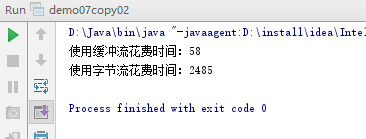一、缓冲字节流
1、缓冲字节输出流(BufferedOutputStream)
1 public static void main(String[] args) throws IOException {
2 /*
3 字节缓冲输出流使用步骤:
4 1:创建FileOutputStream对象,指定输出文件
5 2:创建BufferedOutputStream对象,对FileOutputStream进行“包装”,使其效率提高
6 3:使用BufferedOutputStream对象调用write方法,将数据写入内部缓冲区中
7 4:使用BufferedOutputStream对象调用flush方法,将内部缓冲区的数据刷新到文件中
8 5:释放资源(若释放资源,第4步flush可省略,因为在调用close时会先进行flush再释放资源)
9 */
10 FileOutputStream fos = new FileOutputStream("b.txt");
11 BufferedOutputStream bos = new BufferedOutputStream(fos);
12 bos.write("字节缓冲输出流".getBytes());
13 bos.flush();
14 bos.close();
15 // fos.close();// 不用手动释放,缓冲流释放资源时自动将其内部的字节流进行关闭
16 }
2、缓冲字节输入流(BufferedInputStream)
1 public static void main(String[] args) throws IOException {
2 /*
3 字节缓冲输出流使用步骤:
4 1:创建FileInputStream对象,指定输出文件
5 2:创建BufferedInputStream对象,对FileInputStream进行“包装”,使其效率提高
6 3:使用BufferedInputStream对象调用read方法,将数据读入内部缓冲区中
7 4:释放资源
8 */
9
10 //方式一:
11 /*
12 FileInputStream fis = new FileInputStream("b.txt");
13 BufferedInputStream bis = new BufferedInputStream(fis);
14 int len=0;
15 while((len=bis.read())!=-1){
16 System.out.println(len);
17 }
18 bis.close();
19 */
20
21 //方式二:
22 FileInputStream fis = new FileInputStream("b.txt");
23 BufferedInputStream bis = new BufferedInputStream(fis);
24 int len = 0;
25 byte[] bytes = new byte[1024];
26 while ((len = bis.read(bytes)) != -1) {
27 System.out.println(new String(bytes, 0, len));
28 }
29 bis.close();
30 }
3、测试缓冲流与字符流复制文件的速度
1 package demo09.buffer;
2
3 import java.io.*;
4 import java.util.Arrays;
5
6 public class demo07copy02 {
7 public static void main(String[] args) throws IOException {
8 copy01();
9 copy02();
10 }
11
12 private static void copy02() throws IOException {
13 long start = System.currentTimeMillis();
14 FileInputStream fis = new FileInputStream("c:\1.jpg");
15 FileOutputStream fos = new FileOutputStream("d:\1.jpg");
16 int len = 0;
17 while ((len = fis.read()) != -1) {
18 fos.write(len);
19 }
20 fos.close();
21 fis.close();
22 System.out.println("使用字节流花费时间:"+(System.currentTimeMillis()-start));
23 }
24
25 private static void copy01() throws IOException {
26 long start = System.currentTimeMillis();
27 FileInputStream fis = new FileInputStream("c:\1.jpg");
28 FileOutputStream fos = new FileOutputStream("d:\1.jpg");
29 BufferedInputStream bis = new BufferedInputStream(fis);
30 BufferedOutputStream bos = new BufferedOutputStream(fos);
31 int len = 0;
32 while ((len = bis.read()) != -1) {
33 bos.write(len);
34 }
35 bos.close();
36 bis.close();
37 System.out.println("使用缓冲流花费时间:"+(System.currentTimeMillis()-start));
38 }
39 }

经测试:使用缓冲流比字节流速度要快的多。
注:如果在测试代码中都添加byte数组,则测试效果不明显。
二、缓冲字符流
1、字符缓冲输出流(BufferedWriter)
1 public static void main(String[] args) throws IOException {
2 /*
3 字符缓冲输出流使用步骤:
4 1:创建FileWrite对象,指定输出文件
5 2:创建BufferedWrite对象,对FileWrite进行“包装”,使其效率提高
6 3:使用BufferedWrite对象调用write方法,将数据写入内部缓冲区中
7 4:使用BufferedWrite对象调用flush方法,将内部缓冲区的数据刷新到文件中
8 5:释放资源(若释放资源,第4步flush可省略,因为在调用close时会先进行flush再释放资源)
9 */
10 BufferedWriter bw = new BufferedWriter(new FileWriter("c.txt"));
11 for (int i = 0; i < 10; i++) {
12 bw.write("相信美好的事情即将发生...");
13 bw.newLine();
14 }
15 bw.flush();
16 bw.close();
17 }
2、字符缓冲输入流(BufferedReader)
1 public static void main(String[] args) throws IOException {
2 /*
3 字符缓冲输入流使用步骤:
4 1:创建FileReader对象,指定输出文件
5 2:创建BufferedReader对象,对FileReader进行“包装”,使其效率提高
6 3:使用BufferedReader对象调用read/readLine方法,将数据读入内部缓冲区中
7 4:释放资源
8 */
9
10 // 方式一
11 /*
12 BufferedReader br = new BufferedReader(new FileReader("c.txt"));
13 String s = "";
14 while ((s = br.readLine()) != null) {
15 System.out.println(s);
16 }
17 br.close();
18 */
19
20 // 方式二
21 BufferedReader br = new BufferedReader(new FileReader("c.txt"));
22 int len = 0;
23 while ((len = br.read()) != -1) {
24 System.out.print((char) len);
25 }
26 br.close();
27 }
